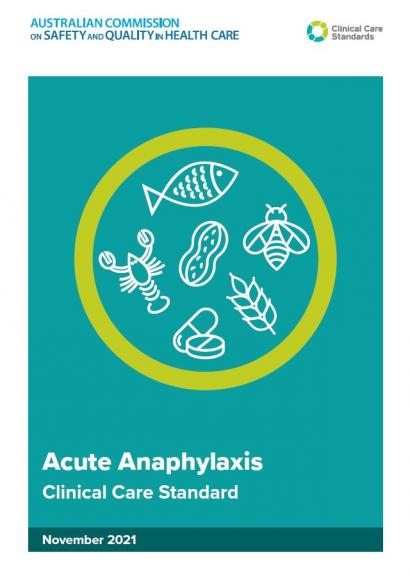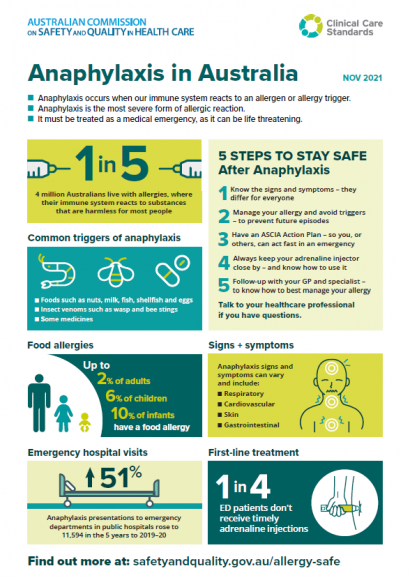Acute Anaphylaxis Clinical Care Standard
This clinical care standard aims to improve the recognition of anaphylaxis, and the provision of appropriate treatment and follow-up care.
Overview
Anaphylaxis is a severe form of allergic reaction that is potentially life-threatening, especially if not treated immediately. It is characterised by a sudden onset; however, the clinical presentation is variable. The diagnosis of anaphylaxis is based on clinical findings and takes the patient’s history and physical examination into consideration.
The Acute Anaphylaxis Clinical Care Standard contains six quality statements and a set of indicators to improve the recognition, treatment and follow-up of anaphylaxis in acute care. The standard will help to ensure that Australians receive prompt treatment to manage severe allergic reactions, and that there is continuity of patient care across healthcare settings.
National launch webcast
The Acute Anaphylaxis Clinical Care Standard was launched on 24 November 2021. Watch the launch recording to see experts in paramedicine, emergency medicine, allergy and general practice discuss and explain the new standard.
The Commission has a suite of promotional resources to assist with implementation of the national Acute Anaphylaxis Clinical Care Standard.
Contents of the standard and resources
The Acute Anaphylaxis Clinical Care Standard contains:
- Six quality statements describing the care that should be provided
- A set of indicators to support monitoring and quality improvement.
The clinical care standard includes guidance for consumers, clinicians, and health service organisations including information about what each statement means, factsheets and additional resources such as the Anaphylaxis discharge checklist and discussion guide and waiting room poster.
Consultation and endorsement
The standard was developed in consultation with a topic working group of clinicians, researchers and consumers. Public consultation on the clinical care standard was carried out between October and December 2020.
The standard is endorsed by a number of key organisations, including the Australasian Society of Clinical Immunology and Allergy (ASCIA), Allergy & Anaphylaxis Australia (A&AA), and the National Allergy Strategy (NAS).
Evidence base
Key sources that underpin the Acute Anaphylaxis Clinical Care Standard are:
- Current clinical guidelines from the Australasian Society of Clinical Immunology and Allergy (ASCIA), including Acute Management of Anaphylaxis (2021)
- The Safer Care Victoria standard, Anaphylaxis Clinical Care Standard (2019).
Further information is available on the evidence base which underpins the Acute Anaphylaxis Clinical Care Standard.
Background
Over four million Australians live with allergies. Food allergy, for example, occurs in around 10% of infants, 4-8% of children, and 2% of adults in Australia.
While not everyone with an allergy is at risk, recent studies show increasing incidence of all-cause anaphylaxis in Australia, the United Kingdom and the United States. In Australia, in the five years to 2019-20
- Anaphylaxis presentations to emergency departments in public hospitals grew by 51% - to more than 11,594 in 2019-20.
- Anaphylaxis hospital admissions increased by 35% - from 9,042 in 2015-16 to 12,179 in 2019-20.
Despite well-recognised guidelines, care is not always provided as recommended. In a study in eight Australian emergency departments, 27% of reactions consistent with anaphylaxis were not given adrenaline. Analysis of fatalities recorded by the Australian Bureau of Statistics between 1997-2013 highlighted gaps between guideline recommendations and patient care, such as delayed treatment with adrenaline.
Infographics and other communication resources
This infographic outlines key data highlights on anaphylaxis in Australia, to support the release of the new standard. You can find more communication resources on our Anaphylaxis Campaign web page.
Contact us
If you have questions about this clinical care standard, please email ccs@safetyandquality.gov.au.
For future updates on standards due to be launched and out for consultation, follow us on X (Twitter) @ACSQHC or subscribe to our eNewsletters.


